Dieter Dengler with his squadron mates from VA-145 in the admiral’s stateroom aboard RANGER, July 22, 1966. COURTESY OF BRUCE HENDERSON.
Dieter Dengler was an American pilot in the Vietnam War. He was shot down, captured, and then spent several months in a small POW camp in Laos before his daring escape. He is the focus of a documentary, book, and movie about his capture and escape. Click here to learn more about this special pilot and what he endured during his imprisonment.
By Stuart Anderson
“A young Navy pilot drew a rare standing ovation yesterday after telling a televised hearing of the Senate Armed Services Committee how he survived six months of captivity in Southeast Asia,” reported the Washington Post on September 17, 1966. “You don’t know what freedom is until you have escaped from Communist capture,” Lt. Dieter Dengler, 28, said in a lingering German accent, according to the Post. “I’m German-born but I’m 100 percent American.”
When Dieter was a boy in Germany, he witnessed Allied bombings of his village. Years later, when he saw an advertisement in an American magazine saying pilots were needed, Dieter decided to immigrate to America. With the help of a relative in the U.S., he took a boat to a new land and joined the U.S. Air Force.
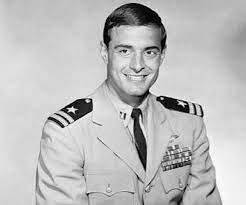
He learned later it would take a college degree and flight school before the Air Force would let him fly. “I had become a United States citizen but my four years ran out before I was assigned to a flying class,” wrote Dieter in his autobiographical book Escape From Laos. “By then I had a new goal: to pass the entrance test to the navy flight course at Pensacola. This I did, and after extensive training, I received orders to Vietnam.”
Bruce Henderson knew Dieter Dengler and interviewed him for his well-written and heavily researched book Hero Found. I asked Henderson to describe Dieter’s state of mind during this period: “In truth, Dieter was an anti-war warrior. Having already lived through one war, and seen it’s terrible impact – including his father being killed – he was not gung-ho about going through another one in Southeast Asia. He didn’t even know where Vietnam was, and when he found out how far away it was he didn’t buy into the argument that it was a threat. However, the Navy taught him to fly, and he knew he had a debt to pay to the service and his new country.”
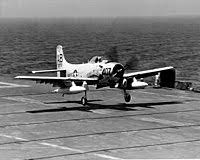
In February 1966, during a bombing run near the Laos-Vietnam border, Dieter Dengler’s plane was shot down. He was captured and for 7 days was interrogated by a province chief. At first the talk was civil. But things took a violent turn after Dieter repeatedly refused to sign a statement attacking America and its “murderous” policies.
In the documentary Little Dieter Needs To Fly, Dieter said he got strength at this time by recalling his grandfather who was ostracized as the only person in his small German town to vote against Adolph Hitler. Dieter’s captors tried various forms of torture against him.
“The province chief stood up,” writes Bruce Henderson. “He went over to the guards, spoke to them quietly . . . Finally unleashed, the guards came for Dieter with a vengeance. They grabbed him, tied his hands behind his back, took him outside, threw him to the ground under a big tree, and started kicking him . . . They tied his ankles together, threw the end of the rope over a limb and hauled him up until he was swinging headfirst off the ground . . . They beat him again until he passed out, and again brought him back for more punishment.”

Soldiers brought Dieter to a small camp where he was held with two other American prisoners of war, Duane Martin and Gene DeBruin, and three Thai prisoners, Prasit Thanee, Prasit Promsuwan and Phisit Intharathat. The prisoners’ feet were locked in blocks each night, though they learned how to open the locks with keys they made.
As the weeks and months passed, food became increasingly scarce. The prisoners ate rats to supplement their meager portions of rice. “The prisoners felt ‘dizzy all the time’ at the slightest exertion,” notes Henderson. “Besides suffering from malaria and untold other tropical diseases and parasites, they had bouts of dysentery, which left them acutely dehydrated.” They also overheard the guards say they would kill the prisoners to avoid having to feed them.
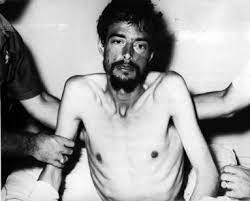
The prisoners decided to escape before they became so weak it would be impossible. They made a scale model of the camp and when enough guards were out of camp to improve the odds of success, they made their move. “In Dieter’s mind, there was no contingency for failure,” writes Henderson. “If they tried to escape and failed, he expected either to be killed in the attempt – his preference – or executed soon thereafter.”
After receiving the word that the guards were together in the kitchen and without weapons, Dieter gave the signal. They squeezed out of their hut and Dieter made it to the porch. He grabbed two Chinese rifles and a U.S. M-1 carbine, as well as extra ammunition.
Dieter felt bullets fly past his head and fired back, shooting a guard who turned out to be armed after all. Another guard came at him with a machete and he shot him, too.
One of the American prisoners, Gene DeBruin, decided to stay behind near the camp with a sick Chinese operator who had been part of his captured flight crew. He and Dieter said good-bye. Gene DuBruin was never seen again.

I asked Bruce Henderson about the negative portrayal of Gene DuBruin in Werner Herzog’s film Rescue Dawn. It was a portrayal that contradicted the facts presented in the books by Dengler and Henderson. “A terrible injustice was done to Gene DeBruin by director Werner Herzog, who made him into a crazy Charles Manson type because he decided he needed a creepy antagonist,” according to Henderson. “Dieter considered DeBruin a stand-up guy whose decision to stay behind with one of the sick prisoners after they took over the camp cost him his life. If Dieter had still been alive when Herzog made the film, I am sure he would have objected mightily to the inaccurate and wholly unfair portrayal of DeBruin.”
Dieter and fellow American POW Duane Martin ran into the jungle and became drenched. It was monsoon season. After a few days, they saw a helicopter but the U.S. pilot had not seen them, or at least did not know they were Americans. Weary and famished, Duane took a chance on finding food in a local village. Dieter went along with him.
A boy saw them and shouted, “Americali!” A villager brandished a machete. By now unarmed, Duane and Dieter fell to their knees. The villager slashed the machete at Duane’s leg and neck. “A stunned Dieter watched as his friend’s dismembered head fell onto the trail, and blood spurted from his neck,” writes Henderson.
Dieter, seeing his friend dead, evaded the next machete blow and ran back into the jungle, where he managed to elude a group of searchers. He made it back to this make-shift camp and lit a large fire when he saw a C-130 fly over. He was certain the pilot saw him.
The next day, Dieter followed behind an enemy search party looking for him and ate some of their leftovers. He later collapsed in the river. The sound of an engine woke him. Lt. Col. Eugene Deatrick, who was flying overhead, saw a man in the river and radioed in the information.
U.S. Air Force Captain William “Skip” Cowell piloted the helicopter sent in to investigate. “One thing that struck Cowell as unusual was that they did not have any idea whom they were picking up, since no aircraft were reported down in southern Laos that day,” notes Henderson.
A hoist was sent down, which Dieter grabbed onto, and he was hauled into the helicopter. Six months after crashing in Laos, Dieter Dengler was free.
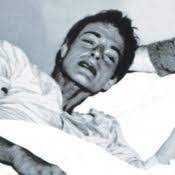
He sent a message to his future wife: “I escaped from prison. Alive in Hospital. Will be home soon. Love you. Dieter.”
But Dieter was in for a long period of recovery. “When he was admitted to the hospital, Dieter weighed 98 pounds,” writes Henderson. “He was found to have two types of malaria, intestinal worms, fungus, jaundice and hepatitis. Doctors said he was so malnourished that if he hadn’t been picked up when he was, he would have ‘died that day or the next.’”
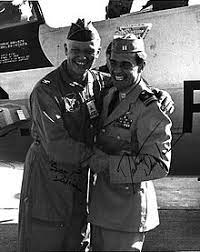
Dieter Dengler became a national hero. His story was in every major newspaper and television broadcast. He received the Navy Cross, one of America’s highest military honors.
He lived a colorful life post-military, opening a German restaurant, becoming a pilot for TWA and marrying three times. He even traveled back to Laos after the war.
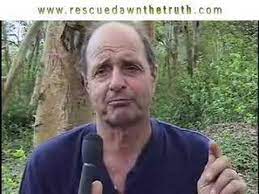
“Dieter was a larger-than-life guy who was always great fun to be around,” Henderson told me. “He grabbed life by the throat and ran with it. His magnetic personality was a draw to men, women and children alike; everyone loved being around him. In a real sense, I think he realized he never should have made it out of the jungle, and any years he had now were a bonus and he was determined not to waste them.”
In 2000, Dieter Dengler was diagnosed with ALS, known by many as “Lou Gehrig’s disease.” In 2001, “Dieter lost the ability to eat or speak coherently. He feared ending up a ‘vegetable,’” according to Bruce Henderson. But he could still hold a gun. He ended his life on his own terms.
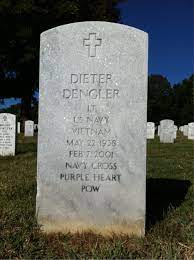
“Dieter was buried on a cool day in March 2001 at Arlington [Cemetery], with full military honors,” writes Henderson. “Complete with a horse-drawn caisson . . . and a flyover of U.S. Navy jets in the traditional missing-man formation for a lost pilot.” The boy who grew up in Germany hoping to fly planes died an American hero.
This article originally appeared in Forbes Magazine, May 20, 2017. Here is the direct link: https://www.forbes.com/sites/stuartanderson/2017/05/20/dieter-dengler-heroic-immigrant-pilot-who-escaped-pow-camp/?sh=418ab14b35fb
<><><>
Admin: Here is my personal Amazon book review of Henderson’s book, HERO FOUND:
Hero Found: The Greatest POW Escape of the Vietnam War
By Bruce Henderson![]() Treated worse than dogs, January 5, 2011
Treated worse than dogs, January 5, 2011

Dieter’s story of survival in the jungles of Laos was a gripping tale to say the least. As a former Army Vietnam veteran myself, all the goings-on of an aircraft carrier intrigued me and have to admit that while reading Bruce Henderson’s story of Dieter Dengler; I found the book to be an enjoyable learning experience for me. It especially took me back when there was mention of a fellow pilot of Dieter’s, Donald Woloczak, from Alpena, Michigan, and how he became MIA during the war. I have been wearing a bronze POW bracelet of Donald Woloczak for the last thirty years, and the information shared by the author was new and seemed to fill in the gaps.
I, too, was born in Germany, but six years after WWII. However, I’ve seen the destruction of war and have heard similar war survival stories from my family in the old country – the experience matures you quickly.
The living conditions and treatment of Dieter and others during their captivity are beyond anything human. But one must do whatever is necessary in order to survive. The chase left me on the edge of my seat, wondering what would happen next. The scene of Dieter and his fellow POW running into the villager took my breath away. It was great that his escape from Laos was successful, but he could not escape from the tormenting in his head. Great job Bruce, and thank you for the education! Five Stars for Hero Found.
*****
Thank you for taking the time to read this. Should you have a question or comment about this article, then scroll down to the comment section below to leave your response.
If you want to learn more about the Vietnam War and its Warriors, then subscribe to this blog and get notified by email or your feed reader every time a new story, picture, video, or change occurs on this website – the button is located at the top right of this page.
I’ve also created a poll to help identify my website audience – before leaving, can you please click HERE and choose the one item that best describes you. Thank you in advance!



Thank you for sharing this incredible story of courage and the will to survive. I stumbled upon the movie and was so moved that I started looking up information on Dieter Dengler. Your article definitely covers all the bases and provides the dignity this man deserved even as his life ended.
LikeLike
Incredible account of an amazing determined aviator.
I had read Dieter Dengler’s 1979 book “Escape from Laos” sometime in the early 80s after seeing him interviewed on a TV morning show. Later while stationed at AMC headquarters in Alexandria I learned that he was to be a guest speaker at some event in DC so of course I attended. Along with the USAF Col Gene Deatrick who had miraculously spotted him while overflying a narrow valley along the VN/Laotian boarder during his in-country A-1E orientation flight out of Pleiku AFB. For reasons that only a true believer might understand Col Deatrick set into action the rescue with an AF Jolly Green ‘copter out of DaNang. Together they presented a detailed account of all that led to his recovery to a fascinated audience that evening.
I had taken my copy of his book to the event so I got his autograph too. Gene Deatrick autographed too. Still have the book. It’s a good read and as so often is the case it lays out his experiences and events without the “adjustments” made by Hollywood movie producers who are seldom satisfied with the true story
LikeLiked by 1 person
>
> Dengler made a survival film some time after his return to the US. It was filmed in a classroom at Naval Amphibious Base, Coronado, CA. In the film Dengler walked over the area of the lectern giving tips on jungle survival. In giving tips on finding food he said, “Americans are generally too squeemish about what they will eat. Almost anything that walks, flies, or crawls has protein in it and can be eaten. For example, this spider,,,,,” He had walked over to the window where he had seen a spider on the window sill. He then smashed the spider with his hand, popped the dead spider in his mouth, and swallowed it. He continued the lecture saying, “It was a little fuzzy and not very tasty, but there was a little protein in it so it was food.”
>
> I saw the film in medical officer orientation class that I had to take right after being called up for active duty in 1972. The classroom where we watched the film was the same one where the lecture had been filmed and I was sitting just a couple of chairs over from that window sill. I looked to see if there were any squashed spider remains there but it had evidently been cleaned sometime after the filming. There were not any spider remains.
>
> All Navy doctors called up right after finishing internship/resident training who were assigned to West Coast Fleet units (not hospitals) were sent to that class. I forget exactly how many of us there were but it was around fifty. It was a two week class. On Monday of week two I came in to class and noticed that the seat next to me was empty. The guy was named Brumfield. I leaned over to the next guy and asked, “Where is Brumfield? This isn’t like college, you don’t get to cut classes.” He looked surprised and replied, “You didn’t hear what happened? Some guy came up to him at the BOQ yesterday and handed him a set of orders. He is somewhere between here and Saigon.” By the time Friday came half the class was gone, all with orders to RVN.
>
> I finished the class and returned to my unit, Destroyer Squadron Seven. I was told that we would be in San Diego for a year before any deployment to RVN. Three months later I was standing outside the door of the transportation center at Fleet Air Support Unit, Da Nang thinking, “I am just a small town guy from Mississippi. What the hell am I doing here!” That door had shrapnel holes in it, not a reassuring thing to see on arrival. When I checked in at the BOQ barracks the clerk who checked me in had been hammering a piece of sheet metal over a hole in the plywood wall. That was also a shrapnel hole. Da Nang got rocketed again that night. One of them landed right by my barracks but it was a dud. I began to think that Ho Chi Minh had some personal vendetta against me. I had orders to be the North SAR medical officer and North SAR station was just off Haiphong Harbor. The USS Reeves was on station there. I went to the transportation office again and asked how I was going to get to the Reeves. Seaman Cannizzaro (the E-3 who ran the place) told me in his strong Brooklyn accent, “Doc, they’re not even in WestPac (Western Pacific) yet. They are on their way from Pearl Harbor.” I did not believe him. I then went over to the Post Office for Da Nang and asked if they were handling any mail for the Reeves. They said they were and it was going out via the USS Ranger. The Ranger was an aircraft carrier. The next day I packed my bag and went over to the flight line near the Post Office. Eventually a helicopter landed that said, “USS Ranger” on the side. I walked over and asked the pilot if he was headed back to the Ranger and he said he was. I threw my bag in and sat down. A few minutes later the postal clerk threw in some mail bags and we took off and headed out to sea. I had had enough of Da Nang for that month. When we landed on the Ranger the ship’s commanding officer came over to the helicopter as I got out. I think the pilot had probably radioed to the Ranger that he had some medical officer aboard on an unknown mission. They gave medical officers a lot of leeway on things. They didn’t expect us to act like “real” Navy officers. The Captain asked me who I was and what was I doing on his ship. I came to attention and gave him a brief summary of what I was up to. He then grinned and told the pilot to fly me on to the Reeves as soon as they had refueled. He knew what North SAR was all about. It would be his pilots that we would be going to get if they had the misfortune to be shot down and he wanted a doctor up there. Getting shot out of the sky, ejecting from a jet, then parachuting into the ocean carries a substantial risk of being severely injured. And we all knew about Dieter Dengler. North SAR’s mission was to get those guys home. A couple of hours later I was aboard the USS Reeves and about to start a whole new set of adventures in life.
>
> Sid Bondurant, MD
LikeLiked by 1 person
Dieter Dengler was a man’s man who deserves recognition for his grit and determination in the face of torture, danger, and death.
LikeLike
Amazing
Sent from my iPhone
>
LikeLike
Wow! Some Vietnam stories are beyond horrific. Thanks for sharing this.
LikeLike
Great article!! I must get the book!
LikeLike
Will someone please make a correction. The plane he was flying was not a biplane. To some that might be a minor error but to many is an egregiously ignorant example of poor writing and editing. Thank You Bill Shirley
Sent from my iPhone
>
LikeLike
Done!
LikeLike
The Spad was indeed a WWI biplane; but, the A-1 Skyraider that Dieter (and I) flew was not a bi-wing plane but was dubbed the the “Spad” by those flying it because by the 1960s it was thought to be such an ancient aircraft that the name fit. Dieter and I got our Naval A iatrogenic wings about the same time at VT-30 (training squadron – 30) at NAS Corpus in Christi, TX in Sept/Oct 1964.
LikeLike
“VIETNAM BEYOND” newly released– by Gerald E. Augustine Â
LikeLike